101st Air Refueling Wing
| 101st Air Refueling Wing | |
|---|---|
|
132d Air Refueling Squadron – Boeing KC-135R Stratotanker refueling an F-22A Raptor | |
| Active | 2 March 1942 – present |
| Country |
|
| Allegiance |
|
| Branch |
|
| Type | Wing |
| Role | Air Refueling |
| Part of | Maine Air National Guard |
| Garrison/HQ | Bangor Air National Guard Base, Bangor, Maine |
| Nickname(s) | "MAINEiacs" |
| Motto | He Strikes As Lightning |
| Tail Code | A white tailband with black text 'Maine' included. |
| Engagements | Burma Campaign 1944–1945 |
| Commanders | |
| Notable commanders | Gabriel P. Disosway |
| Insignia | |
| 101st Air Refueling Wing emblem |
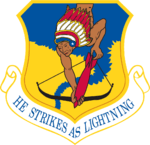 |
The 101st Air Refueling Wing (101 ARW) is a unit of the Maine Air National Guard, stationed at Bangor Air National Guard Base, Bangor, Maine. If activated to federal service, the Wing is gained by the United States Air Force Air Mobility Command.
Overview
The 101st Air Refueling Wing principal mission is air refueling. The wing enhances the Air Force's capability to accomplish its primary missions of Global Reach and Global Power. It also provides aerial refueling support to Air Force, Navy and Marine Corps aircraft as well as aircraft of allied nations. The wing is also capable of transporting litter and ambulatory patients using patient support pallets during aeromedical evacuations.
The Wing also supports the State of Maine by assisting in the protection of life and property, maintaining peace and order, and providing civil defense capabilities. This was evidenced during the 1998 Ice Storm, where the 101st maintained a shelter in its hangar in conjunction with the Red Cross, and sent personnel out to help communities in clean-up operations so that electrical companies could access downed power lines.
Units
The 101st Air Refueling Wing consists of the following major units:
- 101st Operations Group
- 101st Maintenance Group
- 101st Mission Support Group
- 101st Medial Group
History
Maine Air National Guard

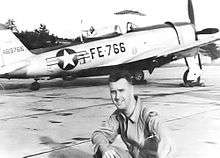
In October 1950, the Air National Guard converted to the wing-base organization. As a result, the 67th Fighter Wing was withdrawn from the Air National Guard and inactivated on 31 October 1950. The 101st Fighter Wing was organized and assigned to the Maine ANG.
Korean War federalization
With the surprise invasion of South Korea on 25 June 1950, and the regular military's complete lack of readiness, most of the Air National Guard was federalized and placed on active duty on 1 February 1951.
The 101st Fighter Group was federalized and ordered to active service on 10 February, being assigned to the Eastern Air Defense Force, Air Defense Command (ADC). ADC changed the status of the 101st from a Group to a Wing, and established the 101st Fighter-Interceptor Wing. The 101st Fighter-Interceptor Group was assigned to the new Wing as a subordinate unit. Support elements of the wing were the 101st Air Base Group; 101st Maintenance and Supply Group, and 101st Medical Group. The 132d, 133d and 134th Fighter-Interceptor Squadrons remained assigned to the 101st FIG.
The mission of the 101st FIW was the air defense of New England. Its assigned squadrons were dispersed and equipped as follows:
- 132d Fighter-Interceptor Squadrons, Dow AFB (F-80C)
- 133d Fighter-Interceptor Squadrons, Grenier AFB (F-47D)
- 134th Fighter-Interceptor Squadrons, Burlington Municipal Airport (F-51H)
On 1 February 1952, the 101st FIW and Group were inactivated, the unit being taken over by the Air Defense Command 4711th Defense Wing at Presque Isle AFB, Maine. The 4711th assumed its mission and its operational squadrons all being transferred to the 4711th DW.
Air defense mission

On 1 November 1952, the 101st FIW, 101st FIG and all of its subordinate units were returned to control of their respective states and their air defense mission. Upgraded to a Wing status by Air Defense Command during its federalization period, the 101st FIW and Group were both federally recognized as Air National Guard units.
With the pending end of its federalization period, the 132d's F-80C jets were transferred to the active-duty 49th Fighter-Interceptor Squadron, their replacement unit at Dow. Upon its return to Maine control, the 132d was re-equipped with F-51H Mustang prop-interceptors. The 133d FIS was also upgraded to F-51H Mustangs. Beginning in 1953, the 101st FIW began holding summer camp at Otis Air Force Base, Massachusetts. Also after the Korean War, all three squadrons had turned in their Mustangs for F-94 Starfire jet interceptors, being re-equipped by the end of 1954 as the obsolescent F-51s had reached the end of their service lives.
The 101st began standing dawn to dusk runway alerts beginning in October 1954 along with their active-duty ADC counterparts. Within three minutes the squadrons could be airborne and heading for a prospective rendezvous point. After identifying any intruders, the interceptor aircraft were supposed to radio back to the Ground Control Interceptor (GCI) station for further instructions.

On 30 April 1954 the 134th FIS was authorized to expand to a Group level, and the 101st Fighter Interceptor Group was withdrawn from Maine ANG and transferred to the Vermont Air National Guard. It was extended federal recognition at Ethan Allen Air Force Base and activated on 1 June 1954. On 15 April 1956, the 101st FIW was re-designated as an Air Defense Wing and moved to Dow AFB. The 133d was also expanded to a group, with the 158th Fighter Group (Air Defense) being activated at Grenier Air Force Base. The same day the 101st at Ethan Allen AFB was re-designated as the 101st Fighter Group (Air Defense).
In 1960, the 101st Fighter Group (Air Defense) was transferred back to Maine state control when the 133d FIS at Grenier AFB was transferred to Military Air Transport Service (MATS) and the 157th Air Transportation Group was established. Also, the 134th at Burlington was reorganized as the 158th Fighter Interceptor Group in mid 1960 and was placed directly under Air Defense Command.

After the transfer of the Vermont and New Hampshire units, the 101st Air Defense Wing at Dow AFB continued its Air Defense mission with the 132d Fighter-Interceptor Squadron, the squadron gradually being upgraded to newer equipment passed down by the Air Force as newer interceptor aircraft entered the Air Force inventory.
In 1968 Dow Air Force Base was closed as a result of Air Force-wide downsizing directed by Secretary of Defense Robert McNamara. The closure was in part directed due to the desire by McNamara to reduce the size of the Air Force B-52 Stratofortress fleet, the increasing cost of the Vietnam War and the change to Intercontinental Ballistic Missilee (ICBMs) as the primary strategic deterrence force.
With the inactivation of Dow AFB in 1968, most of the base was purchased by the city of Bangor and reopened the following year as Bangor International Airport. That portion of Dow AFB not turned over to the city became the basis for the current Air National Guard Base and the Maine Army National Guard's Army Aviation Support Facility.
Air refueling
On 1 July 1976, the 101st was relieved from Aerospace Defense Command and transferred to Strategic Air Command (SAC), becoming a KC-135A Stratotanker unit. This was part of the downsizing of ADCOM, with the probability of an air attack by Soviet bombers and fighters being remote in the age of the ICBM. The 101st was re-designated as an Air Refueling Wing, the 132d as an Air Refueling Squadron.

In 1977, the 132d deployed to RAF Mildenhall, England, as part of the European Tanker Task Force. In 1978, it began to stand alert with the SAC active force. In October 1978 The 101st AFREW along with all other Air Guard Units, underwent reorganization into the Tri-Deputy organizational structure; the 101st Air Refueling Group being inactivated on 30 September.
In August 1979, the 101st became the first Air National Guard unit to host a Tanker Task Force, and during the fall, the 101st joined forces with 16 KC-135A's providing air refueling support for "Crested Cap". This airpower exercise tested the deployment capability of Air Force fighter aircraft moving from the U.S. to Europe in support of NATO war efforts there.
During the 1980s, the 101st continued to participate in Strategic Air Command exercises like Global Shield and Giant Voice. In 1984, the 101st converted from its aging KC-135A fleet with new fuel efficient KC-135Es and the receipt of its first Air Force Outstanding Unit Award. The wing engaged in routine worldwide deployments with its KC-135s.
1990/1991 Gulf crisis
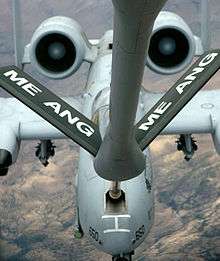
Early on the morning of 7 August 1990, Operation Desert Shield, a build-up of friendly forces designed to contain the spread of Iraqi aggression, began. A telephone alert asked every crew member of the 132d Air Refueling Squadron to provide maximum availability so that an immediate response capability could be developed. All 125 Operations crew members stepped forward in voluntary support.
The unit began functioning on a 24-hour, seven-days-a-week basis. Numerous Desert Shield missions would be flown in the month of August as the 132d helped refuel transport aircraft and fighters heading to United States Air Forces Central (CENTAF) bases in the Middle East. Volunteers were placed on full active duty status for as long as needed. Close to 100 guard members reported during the next few days as additional KC-135s arrived TDY from other ANG units, together with the 132d's own KC-135E aircraft forming an Air National Guard tanker task force. By 1 October, the 101st's heavy support of MAC flights in transit from the West Coast to bases in Saudi Arabia began to slow. The 101st ARW became one of 12 National Guard units tasked with providing refueling support to Air Force units deployed to Saudi Arabia.
On 12 October the 101st began deployment of its assets to Saudi Arabia to form the 1709th Air Refueling Wing (Provisional) at King Abdul Aziz Air Base, Jeddah. Personnel and aircraft, however, were dispersed at several locations in the Middle East, including Al Banteen Air Base, Abu Dhabi, United Arab Emirates; Morón Air Base, Spain; Cairo West Airport, Egypt; and other locations. By January 1991, the build-up of men and material in-theater was complete. Operation Desert Storm, the attack phase of the Allied plan to liberate Kuwait and destroy Iraq's army, was ready to begin. With its strategic location on the Atlantic shore, the 101st mission reverted to an "Air-Bridge" mode, refueling transiting aircraft heading across the Atlantic or inbound from RAF Mildenhall, England, which served on the other end of the transatlantic route to the Middle East.
After a short 100 hours of ground combat, Iraq's elite Republican Guard quickly collapsed and Kuwait was easily recaptured by Coalition ground forces. Emotional returns, punctuated by parades, bands, speeches, tears, and bear-hugs were commonplace in New Hampshire as they were throughout the country. Many deployed units returning from CENTAF bases stopped at Bangor AGB on their way to their home bases. The 101st, its aircraft festooned with yellow ribbons painted above the boom, remained in "air-bridge" mode, supporting the returning traffic. By late April almost everyone had come home safely. There had been no casualties.
Modern era
In March 1992, with the end of the Cold War, the 101st adopted the Air Force Objective Organization plan. The Tri-Deputy organizational structure was revised with the 101st Operations Group, 101st Maintenance Group, 101st Mission Support Group and the 101st Medical Group being formed and the 132d Air Refueling Squadron being assigned to the 101st Operations Group. On 30 June, Strategic Air Command was inactivated as part of the Air Force reorganization after the end of the Cold War. It was replaced by Air Combat Command (ACC). In 1993, ACC transferred its KC-135 tanker force to the new Air Mobility Command (AMC).
The unit engaged in routine deployments and training until 1994 when the 101st began operating in the Northeast Tanker Task Force together with the New Hampshire Air National Guard. The situation in Bosnia-Herzegovina and "Operation Deny Flight" continued to involve 101st aircraft, crews, and support personnel.
In 2001, with the advent of the Global War on Terrorism, Maine ANG KC-135s were used for air refueling aircraft flying Combat Air Patrols over major United States Cities as part of Operation Noble Eagle (ONE). 132d ARS aircraft were deployed to Air Forces Central (AFCENT) in the middle east as Air Expeditionary Units, providing refueling for combat aircraft during Operation Iraqi Freedom (OIF) and Operation Enduring Freedom (OEF) in Afghanistan.
In 2007, the 132d's KC-135E-model aircraft were replaced throughout the summer with quieter, more efficient R-models. With their new CFM-56 engines, a 50 percent decrease in noise resulted, and emissions were reduced 90 percent, while range, fuel off-load capability, and reliability were all increased.
Lineage
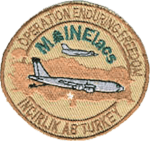



- Established as the 101st Fighter Wing in October 1950
- Activated on 25 October 1950
- Federalized and ordered to active service on 1 February 1951
- Redesignated 101st Fighter-Interceptor Wing on 10 February 1951[1]
- Inactivated on 6 February 1952[1]
- Released from active duty and returned to Maine state control on 1 November 1952
- Activated and received federal recognition on 1 November 1952
- Redesignated 101st Air Defense Wing on 14 April 1956
- Redesignated 101st Fighter-Interceptor Wing on 10 June 1972
- Redesignated 101st Air Refueling Wing on 1 July 1976
Assignments
- Maine Air National Guard, 25 October 1950
- Eastern Air Defense Force, 10 February 1951[1]
- Western Air Defense Force 2 August 1951 – 6 February 1952[1]
- Maine Air National Guard, 1 November 1952 - present
- Gaining commands
- Air Defense Command (later Aerospace Defense Command), 1 November 1952
- Strategic Air Command, 1 July 1976
- Air Combat Command, 1 June 1992
- Air Mobility Command, 1 June 1993 – present
Components
- 101st Fighter-Interceptor Group (later 101st Fighter Group), 10 February 1951 – 6 February 1952; 1 November 1952 – 30 April 1954, 1 June 1954 - 31 March 1956, 15 April 1956 - 1 September 1960[2]
- 101st Fighter Group (later 101st Fighter-Interceptor Group, 101st Air Refueling Group, 101st Operations Group), 1 September 1960 – 31 March 1976, 16 March 1992 – present
- 158th Fighter Group (Air Defense), 15 April 1956 – 1 July 1960
- 132d Fighter Squadron (later 132d Fighter-Interceptor Squadron, 132d Air Refueling Squadron), 31 March 1976 - 16 March 1992
Stations
- Dow Air Force Base, Maine, 25 October 1950[1]
- Grenier Air Force Base, New Hampshire, 23 April 1951[1]
- Larson Air Force Base, Washington, 2 August 1951 - 6 February 1952[1]
- Dow Air Force Base (later Bangor International Airport, Bangor Air National Guard Base), 1 November 1952 – present
Aircraft
- F-80C Shooting Star, 1950–1952
- F-86F Sabre 1952–1955
- F-94A Starfire, 1955–1957
- F-89D Scorpion, 1957–1959
- F-89J Scorpion, 1959–1969
- F-102A Delta Dagger 1959
- F-101B Voodoo 1969–1976
- KC-135A Stratotanker, 1976–1984
- KC-135E Stratotanker, 1984–2007
- KC-135R Stratotanker, 2007 – present
References
Notes
- 1 2 3 4 5 6 7 Cornett & Johnson, p. 63
- ↑ The 101st Fighter Group (Air Defense) was withdrawn from the Maine Air National Guard in 1954. In 1960, it was a unit of the New Hampshire Air National Guard. When it converted to the airlift mission, it was redesignated 157th Air Transport Group and a new 101st Fighter Group was activated in the Maine Air National Guard.
Bibliography
![]() This article incorporates public domain material from websites or documents of the Air Force Historical Research Agency.
This article incorporates public domain material from websites or documents of the Air Force Historical Research Agency.
- Cornett, Lloyd H; Johnson, Mildred W (1980). A Handbook of Aerospace Defense Organization, 1946 - 1980 (PDF). Peterson AFB, CO: Office of History, Aerospace Defense Center. Retrieved March 23, 2012.
- McLaren, David (2004), Lockheed P-80/F-80 Shooting Star: A Photo Chronicle, Schiffer Publishing, Ltd.; First Edition, ISBN 0887409075
- Rogers, Brian. (2005). United States Air Force Unit Designations Since 1978. Hinkley, UK: Midland Publications. ISBN 1-85780-197-0.
External links
- 134th Fighter Squadron lineage and history
- 158th Fighter Wing History
- Cornett, Lloyd H. and Johnson, Mildred W., A Handbook of Aerospace Defense Organization 1946 – 1980, Office of History, Aerospace Defense Center, Peterson AFB, CO (1980).
- 101st Air Refueling Wing website
| ||||||||||||||||||||||||||||||||||||||||||||||||||||||||||||||||||||||||||||||||||||||||||||||||||||||||||||||||||||||||||||||||||||||||||||||||||||||||||||||||||||||||||||||||||||||||||||||||||||||||||||||||||||||||||||||||||||||||||
| |||||||||||||||||||||||||||||||||||||||||||||||
| ||||||||||||||
| ||||||||||||||||||||||||||||||
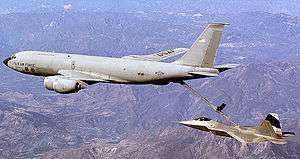


.png)
.jpg)
.svg.png)